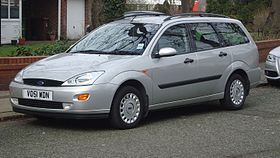Ford Focus (first generation)
| Ford Focus (first generation) | |
|---|---|
 |
|
| Overview | |
| Manufacturer | Ford |
| Production | 1998–2005 (Europe) 1999–2007 (North America) |
| Assembly |
Chungli, Taiwan General Pacheco, Argentina Hermosillo, Mexico Saarlouis, Germany Santa Rosa, Philippines Wayne, Michigan Valencia, Spain Valencia, Venezuela Vsevolozhsk, Russia |
| Designer | John Doughty & Claude Lobo |
| Body and chassis | |
| Class | Compact car / Small family car (C) |
| Body style | 3- and 5-door hatchback 4-door saloon 5-door estate |
| Layout | FF layout |
| Chronology | |
| Predecessor |
Ford Escort (Europe/Latin America/South Africa) Ford Escort (North America) Ford Laser (Asia and Australasia) Ford Contour (North America) |
| Successor |
Ford Focus (second generation, Europe) Ford Focus (second generation, North America) |
| Europe | |
|---|---|
 |
|
| Overview | |
| Production | 1998–2004 2000–2008 (Argentina) |
| Body and chassis | |
| Body style | 3-door hatchback 5-door hatchback 4-door saloon 5-door estate |
| Layout | FF layout |
| Platform | Ford C170 platform |
| Powertrain | |
| Engine | 1.4 L I4 Zetec-SE 1.6 L I4 Zetec-SE 1.8 L I4 Zetec-E 1.8 L I4 Diesel TDDI 1.8 L I4 Diesel TDCI 2.0 L I4 Zetec-E |
| Transmission | 4-speed automatic 5-speed manual 6-speed manual (SVT) |
| Dimensions | |
| Wheelbase | 2,615 mm (103 in) |
| Length |
Hatchback: 4,175 mm (164 in) Saloon: 4,380 mm (172 in) Estate: 4,455 mm (175 in) |
| Width | 1,700 mm (67 in) |
| Height |
Hatchback and saloon: 1,440 mm (57 in) Estate: 1,460 mm (57 in) |
| Curb weight | 1,150 kg (2,535 lb)-1,364 kg (3,007 lb) |
| North America | |
|---|---|
 |
|
| Overview | |
| Production | 1999–2007 |
| Model years | 2000–2007 |
| Assembly |
Wayne, Michigan, United States Hermosillo, Sonora, Mexico |
| Body and chassis | |
| Body style | 3-door hatchback 4-door sedan 5-door hatchback 5-door station wagon |
| Powertrain | |
| Engine | 2.0 L CVH I4 2.0 L Zetec I4 2.0 L Duratec I4 2.3 L Duratec I4 |
| Dimensions | |
| Wheelbase | 102.9 in (2,614 mm) (2005–2007) 103 in (2,616 mm) (2000–2004) |
| Length | 168.1 in (4,270 mm) (2000–2004 hatchbacks) 168.5 in (4,280 mm) (2005–2007 hatchbacks) 174.9 in (4,442 mm) (SE) 175.2 in (4,450 mm) (ZX4) 178.2 in (4,526 mm) (2000–2004 wagon) 178.4 in (4,531 mm) (2005–2007 wagon) |
| Width | 66.7 in (1,694 mm) (2005–2007) 66.9 in (1,699 mm) (2000–2004) |
| Height | 56.3 in (1,430 mm) (2000–2004 hatchback & sedan) 56.8 in (1,443 mm) (2005–2007 hatchback & sedan) 53.9 in (1,369 mm) (2000–2004 wagon) 57.5 in (1,460 mm) (2005–2007 wagon) |
| Curb weight | 2,564 lb (1,163 kg) - 2,759 lb (1,251 kg) |
The Ford Focus (first generation) is a compact car which was manufactured by Ford in Europe from 1998 to 2004 and by Ford in North America from 1999 to 2007. Ford began sales of the Focus to Europe in July 1998 and in North America during 1999 for the 2000 model year.
In Europe and South Africa, the Focus replaced the various Ford Escort models sold in those markets. In Asia and Australasia, it replaced the Ford Laser.
Codenamed CW170 during its development, and briefly known to some Ford contractors as the Ford Fusion, the original Focus took its eventual name from a Ghia concept car which was shown at the Geneva Motor Show in 1991. Certain elements of the design had been seen even earlier in prototypes used by Ford to demonstrate forthcoming safety features, such as the eye-level rear lighting clusters. As a continuation of Ford's New Edge styling philosophy, first seen in the Ford Ka in 1996, and Ford Cougar in 1998, the Focus' styling had been often described as polarising. The styling had been overseen by Jack Telnack and executed by Claude Lobo and Australian designer, John Doughty.
The decision to name the new car the Ford Focus was made in early 1998, as Ford's overheads had been planning to keep the "Escort" nameplate for its new generation of small family cars. A last minute problem arose in July 1998 when a Cologne court, responding to a case brought by the publishers Burda, ordered Ford to avoid the name "Focus" for the German market cars since the name was already taken by the publisher's Focus magazine. This eleventh hour dispute was overcome, however, and the car was launched without a different "German market" name.
Engineers for the Focus, including Richard Parry-Jones, developed a class-leading, space-saving independent multi-link rear suspension, marketed as Control Blade suspension, combining the packaging of a trailing arm, with the geometry of a double wishbone suspension . The system was developed from that used in the CDW27 Ford Mondeo estate, but with various modifications to make it simpler and cheaper to build and therefore economically viable on a mass-market vehicle.
...
Wikipedia
